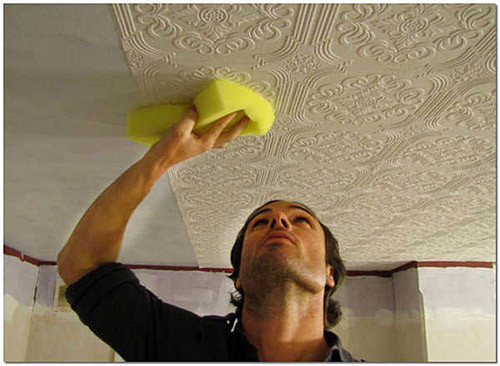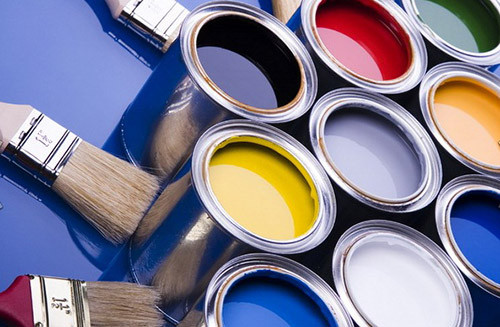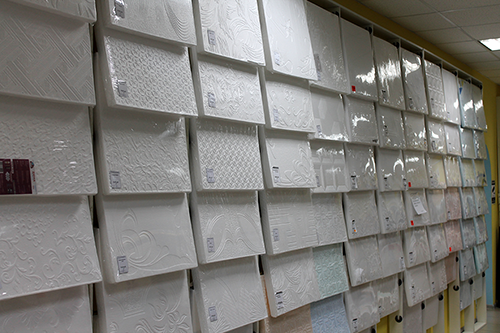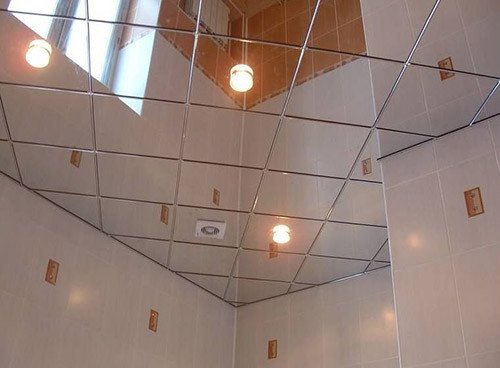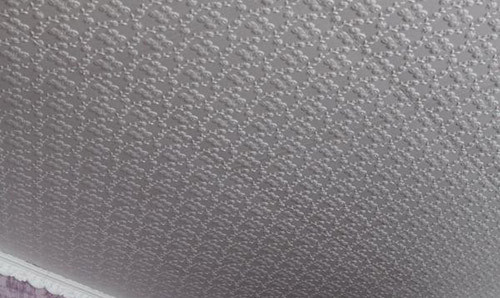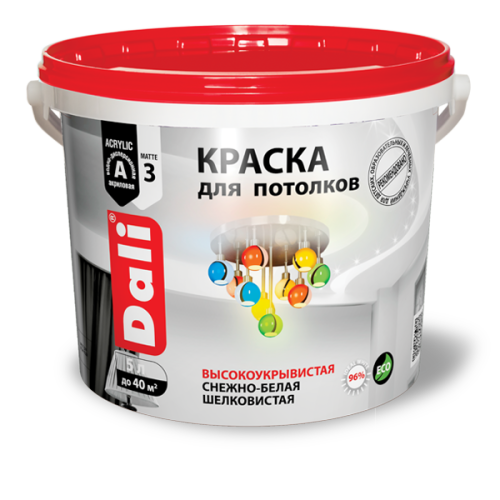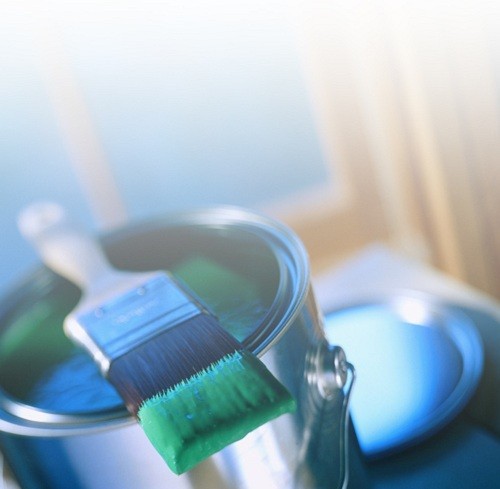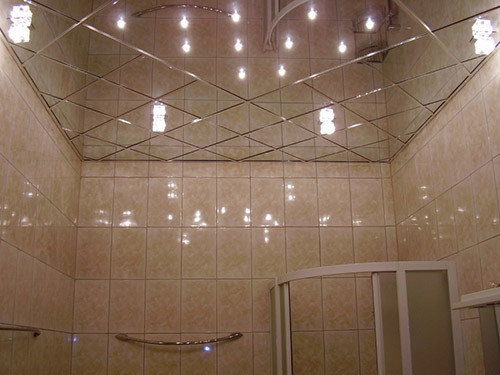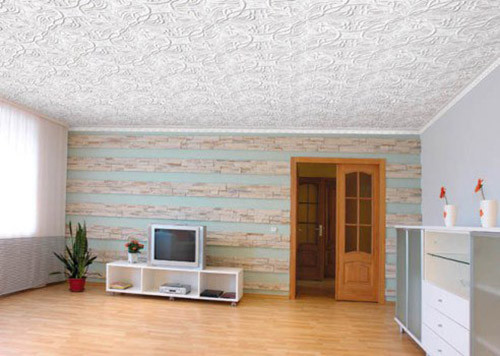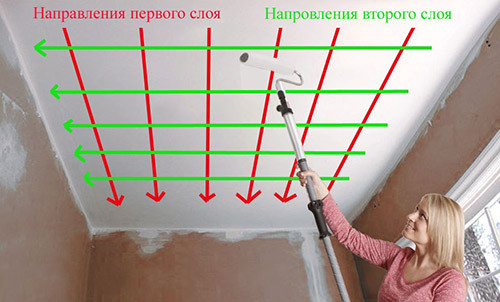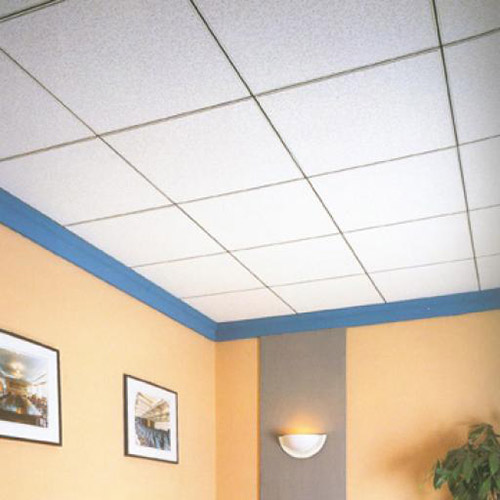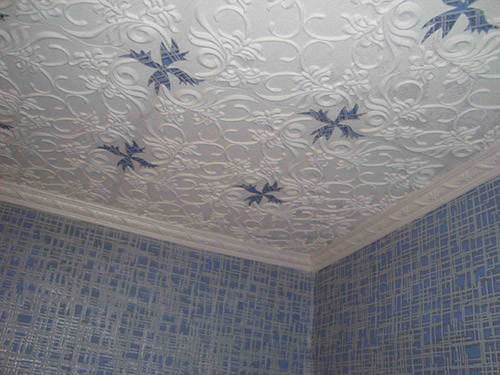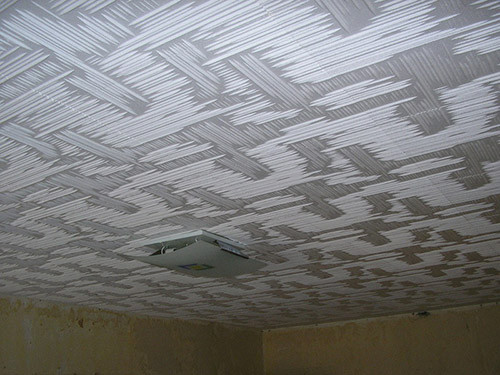
Glue painting ceilkov Ceilings
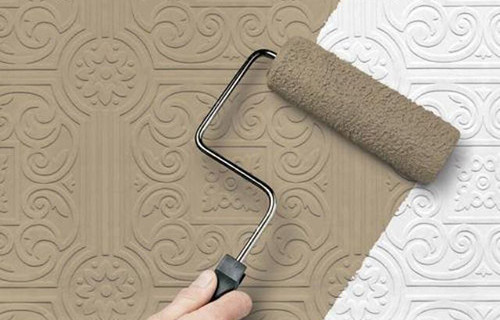
The ceiling decoration is perhaps the most difficult when repairing the premises. It is not easy to work with such a surface, therefore, in the world of finishing materials, new items are constantly appearing, designed to alleviate this occupation. One of these new products at one time was the ceiling tile, and for several decades it remains at the peak of popularity among all other ceiling materials. However, even the most high-quality tile is once updated, but do not rush to be taken for dismantling - you can just paint the surface. About how to paint glue ceilings with your own hands, we will talk in today's article.
Content
Characteristics of adhesive ceiling
Adhesive ceiling is a real salvation for those who want to quickly and without the involvement of professionals make a neat renovation in the room. The technology is very simple - on the prepared surface of the ceiling, you need to glue thin polystyrene or plastic plates with special glue. The relief, coloring and shape of the tiles can be the most different, but usually color material is more expensive than white, and therefore many economical hosts spend color separately. This allows not only to reduce repair costs, but also get the original ceiling design that is harmonizing with the interior.
In general, the adhesive ceiling can be called not only tile, but any type of decorative coating, which keeps on the main ceiling with glue. The only unifying factor is the low weight of the finishing material, since the heavy coating simply cannot be held with glue.
Advantages and disadvantages of glue painting
The peak of the popularity of adhesive ceilings fell on the mid-90s, but even after more than 20 years, this method of finishing continues to be relevant.
Advantages of adhesive ceilings:
- easy installation - even inexperienced person will cope with the ceiling tile sticking;
- the masking of the defects of the surface - the ceiling tile is ideal for repairing in the apartments of the Soviet construction, it can be glued to a pinch surface and even cracked plaster;
- low cost - the price of the adhesive ceiling is from 30-40 rubles / m²;
- tile can be used in low ceilings, without fear that it will visually reduce the room, as often happens with suspended ceilings;
- a wide selection of patterns and textures - tile is smooth, with floral patterns, ornaments, all kinds of textures (waves, wood, stone laying, etc.);
- additional heat and noise insulation ceiling - polystyrene foams are used for insulation of walls inside and outside. Of course, a small thickness of the tiles does not give full heat insulation, but still contributes to energy saving. The porous structure of the material gives additional sound insulation, which is relevant for apartment buildings.
From the shortcomings of the adhesive ceiling, it is possible to highlight its appearance - even if you bought the so-called seamless tile, the joints will be noticeable, although not as much as when using conventional tiles. The only way to neutralize this effect is to paint the tiled ceiling of water-mounted paint. You can use acrylic or silicone dye for this purpose, but it will cost much more expensive.
Although the glue ceiling helps to hide the small surface defects, the differences in height and the angle of the ceiling, it is unable to disguise. Finally, in contrast to the stretch ceiling, the polystyrene tile does not protect against the flooding neighbors from above - the ceiling coating can fall off with the plaster, or there will be ugly drums.
Choosing tile
Since the invention of the adhesive ceilings has passed many years, and today the choice of polystyrene tiles is so great that the unfavorable person easily confused. First of all, the tile must correspond to the operational characteristics of the repaired room: what is the level of humidity, is there temperature differences, etc. From this will depend on the selection of the material of the tile, its density, and then - sizes and textures.
According to the method of production, the following types of ceiling tiles distinguish:
- Extruded - made from polystyrene strips, passing them through the press, resulting in the most subtle among all types of tiles (3 mm). Despite this, the material is characterized by high strength and durability. Again, due to the low thickness, the plates mainly have a smooth surface or a low-rise relief. A variety of product assortment is achieved due to a wide color palette.
- Pressed - manufactured from polystyrene blocks, running them through the press. These tiles are thicker extruded - 5-8 mm, so it can be with a pronounced texture, for example, imitation of wood fibers or various patterns. Mostly produced in white color.
- Injection - material is manufactured by temperature processing. The thickness of polystyrene plates is obtained up to 14 mm. The texture is well pronounced, high performance indicators, all tiles have the right geometric shapes.
There is also a classification for the special operational properties of the finishing material. So, there is a laminated, seamless and even mirror ceiling tile. The first is used in rooms with elevated moisture levels - the glossy coating prevents the moisture absorbing and facilitates the washing. Mirror tiles have a special reflective spraying, imitating mirror. They are ideal for small premises, where a visual increase in space is required. We will tell about seamless ceiling a little later.
However, none of these parameters can talk about the quality of the material - here you need to consider the reputation of the manufacturer. It is convenient that the standard sizes of the tile are 50x50 cm, and 8 pcs are in the package, which significantly simplifies the calculation of the amount of material. There are, of course, there are no standard dimensions like 16.5x100 cm, but mainly for repairs use conventional half-meter products. The quality of the material is the identity of all tiles in the package and the clarity of their geometric shapes. The edges of the tiles must necessarily be smoothly cropped, and the angles are at 90 °. If you choose a product with a grainy structure, make sure the surface is as homogeneous as possible. If you notice that the tiles crumble or break under their own weight, then you sold the poor-quality goods. When buying, make sure that the density and thickness of the products are the same all over the area.
Seamless ceiling
We decided to give a little more attention to a seamless adhesive ceiling, as it is most popular among other types and is often used for coloring. Seamless ceiling tile differs from the usual way of making edges - during docking adjacent elements form a bare seam. With competent installation it seems that the seam is not at all, therefore such a name.
Characteristics of seamless tiles:
- In most cases, products produce from durable foam polystyrene, exposing it to high-temperature stamping, as a result of which the tiles become even more denser.
- The thickness is about 5 mm.
- Packaging Tile Standard Size 50x50 mm (8 pcs) is sufficient for cladding area in 2 m².
- Contours can be smooth or wave-like. Design and drawing are designed in such a way as to the maximum intention to dock (the seams "hide" in the text of the invoice or pattern ").
The most spectacular seamless ceilings are obtained from tile with imitation of plaster stucco, natural texture, wood thread. To get a smooth seamless surface, it is recommended to cover the paint layer.
Coloring ceiling tile
The ceiling takes one of the largest areas in any room, so its appearance can be the determining factor in the interior. In most cases, when repairing the ceiling, it is not paid to the ceiling, believing that it looks like it. But as soon as the setting is changed, for example, the old "grandmother" interior changes to a high-tech or minimalism, the ceiling will noticeably spoil the renovated room.
Painting saves from serious financial and labor costs not only when placing tile ceilings - this method helps to quickly "revive" any surface (facade, furniture, walls, floor). For adhesive painting, the ceilings are not suitable for any paint. Experts recommend using a water-free or acrylic, since they are completely safe for health, quickly dry and cost relatively inexpensively.
Both types of paints are presented in the widest color range, so you can easily create a unique interior. White ceilings have long been bored, and many modern designers offer bold color solutions. Whatever paint you choose, it should be absolutely safe and environmentally friendly, have good covers (giving a smooth color and mask defects). If you are going to paint the ceiling in the bathroom or in the kitchen, choose moisture-resistant washing paint. It is even better if it is resistant to microorganisms (antiseptic). Too glossy paint for the ceiling is better not to take, because it will immediately highlight the seams between the tiles that you strive to disguise.
Acrylic
Acrylic paints for adhesive ceilings are most popular due to its low cost. They give a good dense layer, hiding small defects, quickly dry and hold well on the surface. Almost a complete absence of smell speaks about the non-toxicity of the compositions.
Acrylic paints almost do not fade into the sun, so you can safely use saturated shades. The treated surface has a good moisture resistance, so the paint can be used even for the bathroom. At the same time, it remains vapor permeable, and therefore moisture can freely evaporate from the surface.
Water-emulsion
Water emulsion-based paints are characterized by good working indicators and a wide color palette. They cost cheaper acrylic compositions, completely non-toxic, vapor permeable and easy to use. However, for premises with elevated moisture level and temperature differences, the water emulsion is better not to use.
This paint is ideal for budget repairs in the corridor, children's, bedroom or living room. For the kitchen and bathroom it is better to use acrylic or latex formulations. Some for glue ceiling ceiling use cheap enamels and oil paints, but this is a long outdated method. In addition, such compositions are pretty toxic and harmful to health, and they are better not used in the apartment at all.
Technology coloring
Working with the ceiling is more complicated than with the walls and even more so with the floor, since the paint constantly strives to drop down. Before you take for the tool, protect all the surfaces, then not to rub them away from the paint. If the floor decoration has already been completed, shook it with polyethylene, cover the furniture with a rapid, and better - take it out of the room.
Important: If you want to restore the painting plastic ceiling tile, are forced to disappoint you - this material is not suitable for coloring. The only output is completely or partially replaced by cladding. High-quality color is possible only by polystyrene tile.
Progress:
- Close up with a rag or polyethylene floor film and interior items. Ordinary newspapers will also be suitable. Plinth creemet painting scotch.
- Even if you have been removed to work as accurately as possible, the paint necessarily theft on clothes, so either you have to go into old things that do not feel sorry or buy Rob. Eyes also better protect transparent building glasses - paint, though non-toxic, but from getting into her eyes a nice little. Hair close up light cap or golk.
- All the junctions between the tiles shine and align the putty. Then the paint will fall smaller, and the ceiling will be truly seamless. Instead of putty, you can use an acrylic water-soluble sealant.
- Mix the paint in the bucket or the bank (depending on the selected composition).
- If you spend the color of the laminated tile, it must be preliminarily shied with sandpaper shallow grain. Otherwise, paint will be blown unevenly or rushing into lumps.
- Pour the paint into the greasy pallet, dip the roller and ride it along the dry inclined part of the pallet, to remove paint surplus - if the roller is too wet, the excess paint will be on your clothes.
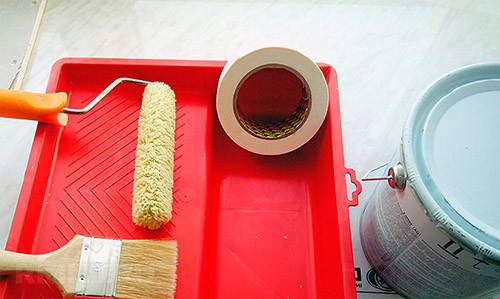
- Start painting the ceiling from any angle, slightly not arguing to the edge of the wall - these places you need to gently cross the narrow painting brush.
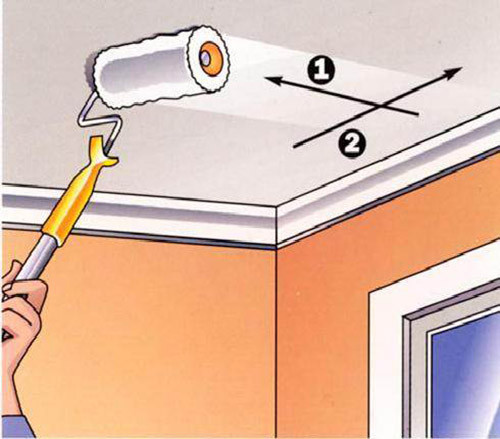
- After drying the first layer, apply the second. Even if the first layer of paint layer is smoothly and beautiful, the second is needed to obtain a more saturated, durable and durable coating.
- For staining of embossed surfaces, it is necessary to use spray equipment - neither a roller nor the brush here will help. Kraspopult can be rented or hired a professional master.
Make a beautiful and neat adhesive ceiling in most cases is much easier and cheaper than working with other types of finishes. We hope the outlined information will help you make quality repairs.




